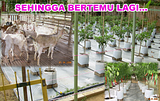
General characteristics
The primary characteristic of the Kiko goat is its hardiness and its ability to achieve substantial weight gains when run under natural conditions without supplementary feeding. In addition, the female is capable of conceiving, carrying and giving birth to and rearing multiple offspring without intervention under less than ideal conditions. The Kiko is an aggressive forager capable of thriving under conditions of feed deprivation and any characteristic which detracts from its ability to range and forage should be severely penalized.
Head
A strong head with bold expression. A moderate forehead lets down into a well proportioned nose, neither convex nor concave. Nostrils wide with slight flare. Eyes generally brown with alert expression. Eye color other than brown should not be penalized. Mouth well formed with tight lips over well fitting jaws: slight undershot permissible as an aid in browsing. Horns well spaced, strong and solid with characteristic outwards sweep.
Mature males display a distinctive shallow spiral in horn conformation. Horns may be cropped in animals greater than twelve months without penalty. Ears comparatively set high and of medium breadth and moderate length, not pendulous. Prick ears undesirable.
Characteristic culling faults
Concave or convex face.
Roman nose.
Overshot jaw.
Excessively undershot jaw so that teeth are visible.
Horns tightly swept back, too close together, touching the neck or too straight
Parrot mouth.
Neck and forequarter
Neck medium in length and well proportioned relative to body capacity: full and well muscled and flowing into forequarter. Shoulder well laid and well muscled with tight attachment. Fore chest prominent and strong but in proportion to body size. Front legs strong with good shoulder angulation - length from wither to elbow should approximate length from elbow to ground. Pasterns strong with well formed hooves.
Characteristic culling faults
Neck too long or too thin.
Bull neck.
Loose shoulders.
Body
Body long, broad and compact. Ribs well sprung and of moderate length displaying good girth. Loins long and well fleshed. Back strong and reasonably straight.
Characteristic culling faults
Excessively short back.
Slab sides.
Hindquarters
Rump broad and flat without severe slope. Thighs well fleshed to the hock. Hocks well angulated. Tail straight and mobile.
Characteristic culling faults
Steep or short rump.
Straight hocks.
Poorly fleshed thighs.
Legs and feet
Strong and well placed indicating endurance and agility. Legs should be parallel, well angulated and turn neither in nor out. Strong hocks and pasterns. Hooves neatly formed with pronounced interdigital division. Any condition of the hoof which affects the animal's ability to move freely should be severely penalized.
Characteristic culling faults
Forelegs turning in or out.
Cow hocks or sickle hocks.
Poor rear angulations.
Dropped pasterns.
Any abnormality of the hoof.
Skin and coat
Smooth supple skin which is neither too tight nor too loose. Some dewlap may be evident in mature males and should not be penalized. Skin may be pigmented or not but darker skin is to be preferred. The coat may vary according to climatic conditions and there is a marked variation between summer and winter coats. Coat may vary from short, slick and lustrous to moderately profuse hair: the former is to be preferred but the latter should not be penalized. Some down appearing in the coat is permissible. Wattles occasionally appear and should not be penalized. The predominant coat color is white which is desirable but any other color is equally permissible.
Characteristic culling faults
None.
Reproductive organs
Males: testicles even sized and well formed. Scrotum ideally undivided, compact and held high. Sheath neat and accessible.
Females: udder well formed, moderately capacious and well attached. Two well placed, medium sized, functional teats with adequate orificies. Non-functional supernumerary teats should not bre penalized.
Characteristic culling faults
Males:
Divided scrotum.
Small testicles.
Pendulous scrotum.
Loose sheath.
Females:
Split udder.
Pendulous udder.
More than two functional teats.
Poor udder attachment.
Either sex:
Hermaphroditism.
Size and appearance
A medium to large animal displaying the ability to produce meat. Mature animals tend to be square with the height of the animal from the wither to the ground approximating its length from the wither to the root of the tail. The fore chest should reach the elbow of the foreleg. Males are distinctively larger than females and each sex unmistakably displays the characteristics of its gender.
Characteristic culling faults
Excessive leg length.
Insufficient size.
Masculine females.
Feminine males.











3 comments:
Jual bibit (cempe) Kambing Boer Super bobot bisa mencapai 100 kg, Peranakan Etawa (PE) Ras Gunung Kawi, Jawa Randu, Domba Merino dan Ekor Gemuk untuk diternak kembali atau untuk usaha bisnis penggemukan. Kami juga jual Kambing & Domba siap potong untuk Qurban & Aqiqah. Hub. Bpk Heru Ketua Pusat Budidaya Kambing & Domba Bejo Utomo - Malang - Jawa Timur. Hp/Wa +6281334272800 website kami di www.malangkambingdombasuper.blogspot.com
Jual bibit (cempe) Kambing Boer Super bobot bisa mencapai 100 kg, Peranakan Etawa (PE) Ras Gunung Kawi, Jawa Randu, Domba Merino dan Ekor Gemuk untuk diternak kembali atau untuk usaha bisnis penggemukan. Kami juga jual Kambing & Domba siap potong untuk Qurban & Aqiqah. Hub. Bpk Heru Ketua Pusat Budidaya Kambing & Domba Bejo Utomo - Malang - Jawa Timur. Hp/Wa +6281334272800 website kami di www.malangkambingdombasuper.blogspot.com
Jual Kambing silangan Alpine france fullblood dengan Saanen fullblood. Kambing langka mempunyai nilai bisnis penghobi dan ekonomis tinggi karena di indonesia masih langka. Tinggi dan bobot kambing diatas rata - rata kambing lokal. Hubungi Bpk Heru "BEJO UTOMO FARM" MALANG - JAWA TIMUR. HP/WA 081334272800 blog saya di www.malangkambingdombasuper.blogspot.com
Post a Comment